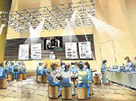Chubu Community for Millennial Symbiosis
 |
 |
 |
 |
|
|
| Exhibitors |
: |
Chubu Region Exhibiting Committee
|
Toyama Prefecture, Ishikawa Prefecture, Fukui Prefecture, Nagano Prefecture, Gifu Prefecture, Shizuoka Prefecture, Aichi Prefecture, Mie Prefecture, and Shiga Prefecture
|
|
| URL |
: |
http://mag.cjn-online.com/chubu2005/ |
|
Theme: A 1,000-year adventure involving the discoveries and creations of the Central Japan region - Thinking about a society that can be sustained for 1,000 years
Subterranean resources will eventually be depleted if we continue to use them. There are, however, resources on the Earth that will be sustainable even 1,000 years in the future. These are the biological resources all around us, including plants, animals, and insects. The Chubu Community for Millennial Symbiosis aims for the realization of a recycling society. In order to pass on a prosperous society to the children of 1,000 in the future, who will not be able to depend on oil and other subterranean resources, the challenge is to work toward sustainable craftsmanship that utilizes the biological resources of different regions.
 |
 |
 |
Image of Pavilion Exterior
As a symbol of biological resources, the outside of the pavilion will be decorated with various types of Japanese paper from the Central Japan region and the cocoons of Indonesian silk moths.
Using interior lighting, the entire pavilion will be enveloped in soft light at night.
|
|

Golden Cocoon (upper left)
|
Image of Exhibits
Passing through an illusionary dome created by water brings visitors to the main zone of the pavilion - the Millenary Academy Arena. Each of the nine prefectures comprising the Central Japan region will exhibit their own characteristic products that will last for 1,000 years. Visitors will be introduced to the appeal and limitless possibilities that can be brought forth from four renewable sources of power - plant power, insect power, animal power, and microorganism power - when combined with human power.
|
|

|
Image of Workshop
Through seminars and experiential classes on the topic of biological resources, this zone will put visitors in contact with the people who possess the techniques and wisdom handed down over time in the nine prefectures that comprise the Central Japan region.
|
|

|






